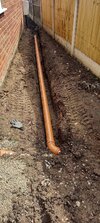Parts of my house have 3 bricks below dpc exposed above external ground level. House is a detached 1960s bungalow on relatively flat ground.
What I would like to know is - is this ok and what are the limits? I know that there are supposed to be at least two bricks courses between an outside surface and the dpc, but how much is too much? How about 4 or 5 courses? Another way of asking might be, what is the minimum amount of earth or other material that has to sit above the foundations alongside a house up against the exterior wall that rises from the footings?
Thanks
What I would like to know is - is this ok and what are the limits? I know that there are supposed to be at least two bricks courses between an outside surface and the dpc, but how much is too much? How about 4 or 5 courses? Another way of asking might be, what is the minimum amount of earth or other material that has to sit above the foundations alongside a house up against the exterior wall that rises from the footings?
Thanks






